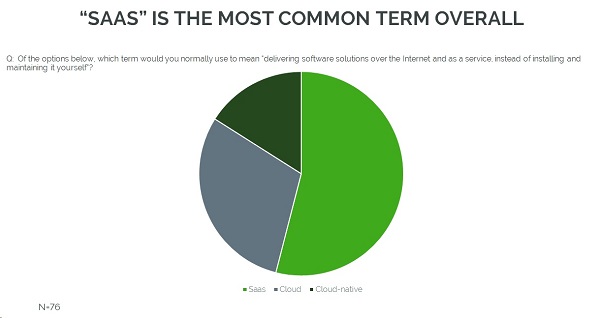SaaS vs. Cloud: Terminology Check
Given the pace of technology, it is understandable that not everyone understands terms such as artificial intelligence (AI), machine learning, augmented reality (AR), cloud, or software as a service (SaaS). Even ubiquitous terms like digital transformation can sometimes feel like they have a dozen different meanings. Some of this comes from over-zealous marketers who spend less time defining what they’re talking about and more time telling you how it will change the world. The other, less glamorous but more relevant reason is that, for an encompassing term like digital transformation, it has different definitions in different contexts.
That said, when conveying any aspect of the digital transformation, it is vital to level-set. With that in mind, let’s turn to SaaS, which sometimes is used interchangeably with terms like cloud or cloud-native. So, are they synonyms?
According to many respondents in a recent PTC study, terms like cloud, cloud-native, and SaaS are often used interchangeably to describe the same definition, which is “delivering software solutions over the Internet and as a service, instead of installing and maintaining it yourself”. SaaS may have been the most popular term applied, but only with a 54% majority, meaning nearly half of respondents believe either cloud or cloud-native to be the correct term. While we can certainly understand the confusion surrounding digital transformation terminology, we believe it’s part of our responsibility to set the record straight. So, how does PTC define cloud, cloud-native, and – most importantly – SaaS?

Understanding the Cloud and Cloud-Native
SaaS is not a synonym for either cloud or cloud-native, however the concepts are related. Cloud (commonly shorthand for cloud computing) refers to transferring computing processes or data storage – sometimes entire software infrastructure – away from on-premises hardware to third- party servers. Think of email. Even a user’s email is not stored on their computer, it is just accessible. The host server, however, does listen to input from the user (if a user deletes an email, the cloud server should eventually delete it too).
Before advancements in internet technology, such as 4G (now5G) and broadband, connection speeds were too slow for this type of computing to be practical. Now, it isn’t just practical, it is often cheaper than hosting and maintaining the servers onsite. With cloud becoming increasingly accessible, it is only natural for certain organizations – including PTC – to see the value in developing or acquiring solutions built on cloud principles and architecture, or cloud-native. Cloud-native software is any software application designed and created with cloud computing in mind. Onshape is PTC’s cloud-native CAD – the only product development platform to deliver full featured CAD.
By being cloud-native, Onshape can provide consistent versioning throughout the design process. Any change made by an authorized user is simultaneously updated for all other users, meaning anyone logging in is guaranteed to see the latest version. Organizations using Onshape also don’t need to invest in the latest processing power just to utilize the platform. By moving the processing and data storage off-site to a secure third-party server, the barriers to entry are lowered and the potential user base expands.
What Is SaaS? Is SaaS Cloud?
SaaS, in principle, has little directly to do with the cloud – or the internet in general. SaaS, as its full name suggests, refers to a business system wherein software is leased to users for a recurring price. This cost can be incurred every month, every six months, every year – it’s flexible. Before the digital transformation and industry 4.0 really kicked off, SaaS was often done through mail. Companies would send out the latest version of their software to leasing clients and provide phone support through the installation and updating process.
Now, of course, the leasing process operates differently – and here is where the cloud comes in. Everything is done through the cloud, whether the software in question is cloud-native or not. New versions are offered online and largely automatically downloaded and installed. Many call switching to SaaS “the last update you’ll ever have to do”, reflecting the time savings in software management.
So SaaS is a method of software delivery, and cloud is now almost always in infrastructure through which it operates. The concepts have become tied but are not strictly interchangeable. Yes, those using platforms like Dropbox or Google Drive are essentially using basic cloud services as SaaS, but it is still SaaS. The service may be “free” in terms of money, but that often simply means certain user data is being exchanged – or the free version merely exists as a promotion.
The Future of SaaS and Cloud
Cloud technology has come a long way. The increasing speeds have made it possible to move more demanding processing needs away from on-premises solutions. As more users gain access to high-speed internet, and the overall connection speed increases further, cloud systems will only grow more robust. Fledgling technologies like virtual and augmented reality are, at least to an extent, depending on this improvement to increase capabilities without making bulky, heavy headsets.
For SaaS, the strengthening of cloud will only mean an expansion. SaaS solutions will grow more diverse as more functions are enabled in the cloud. It is no exaggeration that we at PTC see SaaS as a major, and most likely THE major product delivery model in the future. It is already a comprehensive and robust delivery method, and we feel products like Onshape, Arena, and the recently debuted Windchill+ (video below) only demonstrate its viability.